Art History
A look to the past guides in the future.
Nineteenth Century
1800 to 1880
Romanticism a somewhat vague movement involving violent activity, bold brush strokes and rich colors take over.The most significant artist in Spain during this period in history was Francisco Goya. Goya's early works showing the aristocracy at play are similar to Watteau's and Fragonard's paintings done in the Rococo style. But later his style changed dramatically. In a series of etchings entitled Disasters of War, Goya recorded the horrors associated with the invasion of Spain by French troops in 1808 under Napoleon .
Art of Francisco Goya
Romanticism a somewhat vague movement involving violent activity, bold brush strokes and rich colors take over.The most significant artist in Spain during this period in history was Francisco Goya. Goya's early works showing the aristocracy at play are similar to Watteau's and Fragonard's paintings done in the Rococo style. But later his style changed dramatically. In a series of etchings entitled Disasters of War, Goya recorded the horrors associated with the invasion of Spain by French troops in 1808 under Napoleon .
Art of Francisco Goya
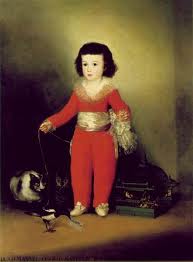 |
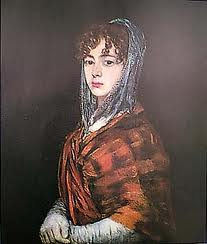 |
 |
| Manuel Osorio | Senora Sabasa Garcia | Colossus |
In the 1850s, the Realists, at first inconspicuous come to the forefront. Nature and life for the first time depicted in an honest and unsentimental way. Meanwhile, the pre-Raphaelites imitate the style that preceded Raphael and photography is invented. Artists practicing this new style expressed little interest in exotic, romantic subject matter. Instead, they looked closely at the objects and events around them to find worthwhile subjects for their art.
One of the first artists to use the Realistic style was the caricaturist, painter, and sculptor Honore Daumier Although Daumier may have wanted to create more paintings, poverty forced him to spend much of his time making lithographs for publication. Lithographs are prints made from inked stones or metal plates. Many of the four thousand he produced criticized the social and moral injustices of his age. Daumier's drawings show us that he was one of the great drafters of all time.
Gustave Courbet was the acknowledged leader of the Realist movement in France. Courbet believed that artists should use direct experience and paint only what they had seen and understood.
One of the first artists to use the Realistic style was the caricaturist, painter, and sculptor Honore Daumier Although Daumier may have wanted to create more paintings, poverty forced him to spend much of his time making lithographs for publication. Lithographs are prints made from inked stones or metal plates. Many of the four thousand he produced criticized the social and moral injustices of his age. Daumier's drawings show us that he was one of the great drafters of all time.
Gustave Courbet was the acknowledged leader of the Realist movement in France. Courbet believed that artists should use direct experience and paint only what they had seen and understood.
Art Works
Since he exhibited his paintings with Courbet's, Edouard Manet was considered to be a part of the Realist movement. His work, however, is actually a bridge between Realism and the art movement that followed, Impressionism. Much of Manet's work was inspired by his study of the old masters, including Raphael, Giorgione, Titian, Velazquez, and Hals.
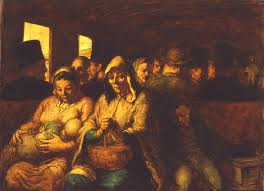 |
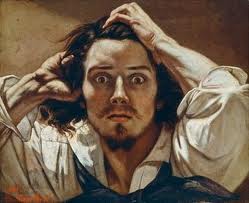 |
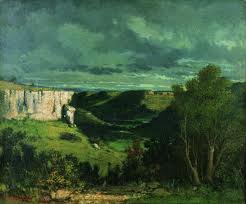 |
| Third Class Carriage Honore Daumier |
Desperate Man Gustave Courbet |
Valley of Love Gustave Courbet |
Since he exhibited his paintings with Courbet's, Edouard Manet was considered to be a part of the Realist movement. His work, however, is actually a bridge between Realism and the art movement that followed, Impressionism. Much of Manet's work was inspired by his study of the old masters, including Raphael, Giorgione, Titian, Velazquez, and Hals.
Art works by Manet
Artists who reject academic painting band together. they create works of art which depict the effects that light has when it falls on objects in the great outdoors, Impressionism is born and the greatest art movement since the renaissance is in full swing. Using the contemporary scene, as Courbet and Manet did, the Impressionists tried to reproduce an impression of what the eye sees at a specific moment in time - not what the mind knows is there. They were attracted most often to the landscape, with or without people.
The best known of the Impressionists was Claude Monet. Working outdoors, Monet became fascinated by constantly changing colors. He often painted the same subject under different light conditions.
 |
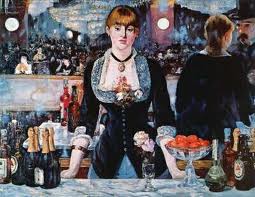 |
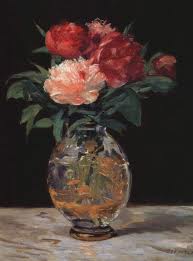 |
| Boating |
Bar Maid |
Bouquet of Peonies |
Artists who reject academic painting band together. they create works of art which depict the effects that light has when it falls on objects in the great outdoors, Impressionism is born and the greatest art movement since the renaissance is in full swing. Using the contemporary scene, as Courbet and Manet did, the Impressionists tried to reproduce an impression of what the eye sees at a specific moment in time - not what the mind knows is there. They were attracted most often to the landscape, with or without people.
The best known of the Impressionists was Claude Monet. Working outdoors, Monet became fascinated by constantly changing colors. He often painted the same subject under different light conditions.
Art works of Claude Monet
Auguste Renoir, another Impressionist, carefully arranged his compositions. His subjects were posed to look as if the viewer had encountered them accidentally. His works show a love of warm colors, appealing subjects, and sun-drenched landscapes.
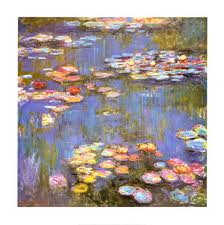 |
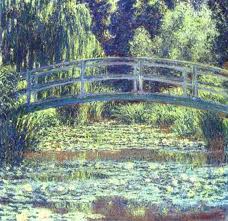 |
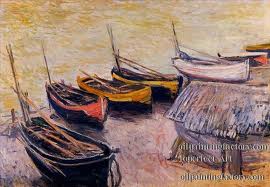 |
| Waterlilies |
Japanese Footbridge |
Boats on the Beach |
Auguste Renoir, another Impressionist, carefully arranged his compositions. His subjects were posed to look as if the viewer had encountered them accidentally. His works show a love of warm colors, appealing subjects, and sun-drenched landscapes.
Art works of Auguste Renoir
Cézanne's art, misunderstood and discredited by the public during most of his life, grew out of Impressionism and eventually challenged all the conventional values of painting in the 19th century through its insistence on personal expression and on the integrity of the painting itself. He has been called the father of modern painting.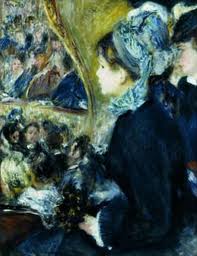 |
 |
 |
| At the Teater |
Ball at the Moulin de la Galette |
Roses |
Edgar Degas agreed with the Impressionists' views, but he didn't regard himself as a Impressionist. Rather than paint out- doors, he remained in his studio. He maintained that drawing wasn't recording what the artist sees, but making others see. Degas also preferred to draw and paint figures rather than landscapes. Degas's affection for drawing, which was inspired by his admiration for Ingres, also separated him from the Impressionists.
Art Works of Edgar Degas
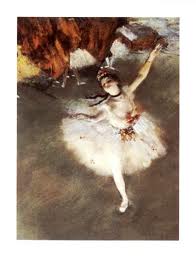 |
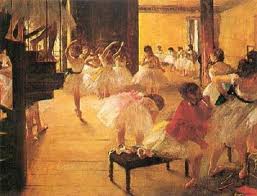 |
 |
| Ballerina |
Ballet School |
In the Cafe |
As the nineteenth century entered its final quarter, a number of artists, including Georges Seurat, Paul Cezanne, Vincent van Gogh, Henri de Toulouse-Lautrec, and Paul Gauguin, tried to solve the problems they associated with Impressionism, Their efforts greatly influenced artists in the next century.
Georges Seurat developed a style of art known as Neo-Impressionism or Pointiliism. He deliberately applied tiny, uniform dots of pure color to his canvases instead of using a more uneven color pattern of dabs and dashes. Seurat was also a splendid drafter. He is noted for drawings done in black conte crayon
Georges Seurat developed a style of art known as Neo-Impressionism or Pointiliism. He deliberately applied tiny, uniform dots of pure color to his canvases instead of using a more uneven color pattern of dabs and dashes. Seurat was also a splendid drafter. He is noted for drawings done in black conte crayon
Art works of Georges Seurat
While the Impressionists were concerned with the appearance of objects under different light conditions, Paul Cezanne was interested in the structure of those objects. His paintings seem to be made out of cubes of color that turn in a variety of directions 
|
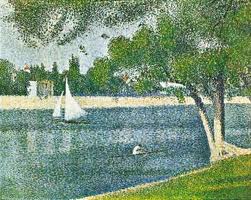 |
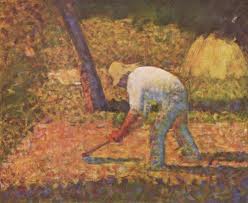 |
| Un dimanche après-midi à l'Île de la Grande Jatte | Sunday afternoon on La Grande Jatte.jpg |
Farmer with ax |
Art works of Cezanne
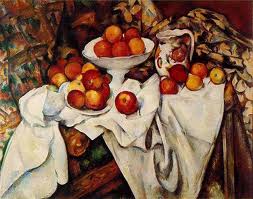 |
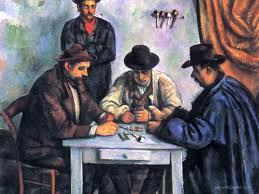 |
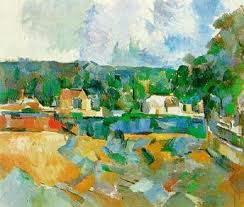 |
| Apples & Oranges |
Card Players |
Landscape |
Vincent van Gogh was a Dutch post-Impressionist painter whose work had a far-reaching influence on 20th century art for its vivid colors and emotional impact. In 1886 Vincent van Gogh moved first to Paris and later to Arles in the south of France to develop his artistic skills. His style is characterized by vibrant colors, twisting lines, and heavy applications of paint . An increased emphasis on drawing separated him from the Impressionists. His lack of realistic accuracy and smooth, finished technique aroused critics. He suffered from anxiety and increasingly frequent bouts of mental illness throughout his life, and died largely unknown, at the age of 37, from a self-inflicted gunshot wound.
Art works of Vincent van Gogh
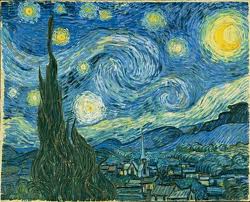 |
 |
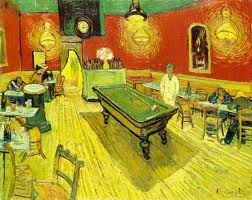 |
| Starry Night |
Sunflowers |
Night Cafe |
Although he didn’t belong to any group of artists or art movement, Henri de Toulouse Lautrec also contributed significantly to the development of modern art. A brilliant drafter, Lautrec was able to capture a scene, a character, even an emotion with a few quick strokes of pencil, pen, or brush.
Art works of Henri de Toulouse Lautrec
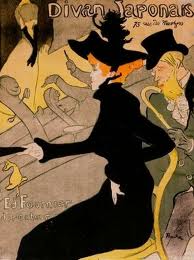 |
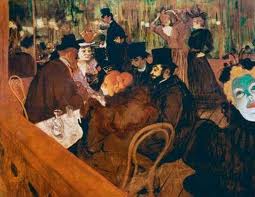 |
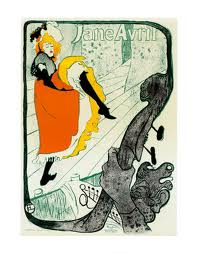 |
| Divan Japonais |
At the Moulin Rouge |
Jane Avril |
Paul Gauguin began his artistic career in his middle years after leaving his family and a high-paying position as a stockbroker. In his work he distorted or exaggerated ordinary natural forms and colors. Seeking exotic subject matter, Gauguin spent much of his career in the South Seas. An ink drawing with watercolor shows the way he used flat shapes to make decorative patterns.
Art works of Paul Gauguin
 |
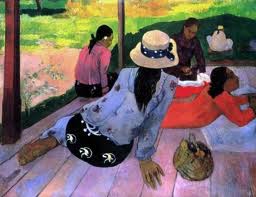 |
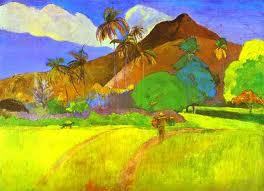 |
| Cat |
Siesta |
Tahitian Landscape |